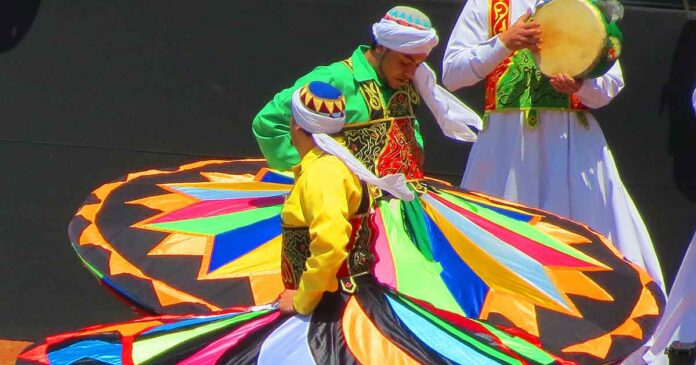In Youssef Chahine’s 1997 historical film Al Maseer (‘Destiny’), twelfth century Caliph Yaqub Al-Mansur’s youngest son, Abdallah (Hani Salama) is recruited by Islamist extremists, who launch war on Andalusian philosopher Ibn Rushd (Nour Al-Sherif) and the band of bohemian artists who rally behind him in support.
Amidst the ideological battle, Abdallah finds himself torn between the Islamists’ austere views and his lifelong passion for music and dance — an internal conflict which culminates in the film’s most powerful musical sequence.
The character’s journey points to a larger debate in the Muslim world surrounding the status of music in Islam.
I lived happily indifferent to this debate until last April, when I shared a list of Ramadan concert recommendations, under which several people expressed the view that music was contrary to the spiritual ethos of fasting from drink, food, and activities which are deemed sinful.
A few days later, just before Eid, a widely shared thread on the topic stirred controversy on Twitter. The author voiced her shock at the number of Muslims who attend concerts despite what she perceived as an obvious religious prohibition.
Reading through the replies, I wondered: where did the notion of an inherent opposition between music and Islam come from? Moreover, how have these views made their way to Egypt — a country with a long and rich tradition of spiritual music?
An Age-old Relationship
The relationship between Islam and music is as old as it is contentious. When the Prophet first instituted the call to prayer, adhan, in the early seventh century, he selected the Abyssinian Bilal as the first muezzin, chosen for his beautiful singing voice.
In pre-Islamic times, poet-musicians were revered in tribal society and held a special place in the courts of Arabian kings. Following the advent of the Muslim faith, religious music swiftly grew from the Bedouin tradition of lyrical poetry, which was primarily vocal but occasionally accompanied by instruments.
As such, the first four Caliphs (~632 – 661 AD) were marked by a vibrant cultural life in the holy cities of Mecca and Medina, where wealthy families hosted salons and contests among both locals and foreign converts to crown the most talented musical performers.
As a result of the Islamic conquests, religious music was also influenced by the musical traditions of the conquered territories, leading to the introduction of new instruments, like the oud, a descendant of the Persian lute. Vocal methods inspired by Coptic chanting were also adopted.
In 750 AD, the establishment of the Abbasid dynasty, which ruled for five centuries, propelled what is now known as the golden age of Islamic music, chronicled in tenth century scholar Abu Al Faraj Al-Isbahani’s Kitab Al Aghani (‘Book of Songs’).
Scholars like Al-Kindi wrote extensively on the theory of ethos (ta’thir) and the cosmological aspects of music. Ibn Sina, meanwhile, studied sound, rhythm, composition, and instruments, laying the foundations of a rich body of Islamic musical theory.
Among the era’s most prominent musicians were Ibrahim Al-Mawsili and his son Ishaq, credited with developing the practices of Ibtihalat and Inshad Dini — two forms of devotional poems recited with musical accompaniment and expressing the believer’s reverence to and love of God and the Prophet Mohamed.
Nowhere was the relationship between music and spirituality more overt than in Sufism, which is said to be as old as Islam itself, but developed into different orders formed around spiritual founders in the twelfth century.
Mass chanting, dance, long instrumental solos, and devotional love poems formed an integral part of Sufi Dhikr (remembrance of God) ceremonies, with music seen to bring its listener into a trance-like state, facilitating internal self-knowledge and unity with God.
In the late nineteenth and early twentieth centuries, Egypt led the revival of these musical traditions with regional icons like Umm Kulthum, Abdel-Halim, and Shadya all performing Ibtihalat throughout their careers. The artforms were further mainstreamed through radio and later television broadcasts in the 1960s, with voices of legendary munshideen like Sheikh Sayed Al Naqshabandi’s coming to form pillars of Egyptian spiritual life.
A Contentious Status
The Quran makes no explicit mention of music, and yet, throughout history, many scholars have held the view that it is prohibited or regarded negatively in Islam. Opponents of the artform base their arguments on hadiths (sayings of the Prophet), and one in particular, reported by ninth century scholar Imam Al-Bukhari.
This hadith reads, “There will be people from my Ummah [nation] who will seek to make lawful the following matters: fornication, the wearing of silk, the drinking of alcohol, and the use of musical instruments.”
People on both sides of the debate have interpreted the saying differently. Followers of more orthodox schools of thought, like Salafism or Wahhabism, understand it as a plain prohibition on music and the use of instruments.
Others, including eleventh century Persian scholar Imam Al Ghazali, have put forward the mitigated view that music in itself is not sinful, but songs which entice their listener to immorality should be avoided — a view echoed by former Grand Mufti of Egypt, Sheikh Ali Gomaa.
In 2017, an article published by Egypt’s Dar Al-Ifta contributed to the now-widespread debate. It argued that reference to music in the hadith was included to paint a clear picture of ‘the licentious night,’ but unlike alcohol and adultery, it is not sinful in and of itself.
Whatever the argument’s merits, it did not gain particular prominence in Egypt nor interfere with the country’s rich musical life until the 1970s, a period which marked an important turning point for Egyptians Muslims’ relationship to their faith.
Egypt’s defeat in the 1967 war against Israel, the contentious signing of the Camp David Accords in 1978, and the spread of Wahhabism among Egyptian migrants returning from Saudi Arabia, were all factors that laid the groundwork for a growing Islamist movement to rise in popularity.
Over the next decades, debates about Islamic morality took center stage in public discourse and cultural life. A study published by the American University in Cairo finds that this surge in piety had a two-fold effect on the relationship between Islam and music in the country.
On the one hand, the 1980s witnessed growing religious animosity towards the arts, and particularly women’s involvement in the musical profession. Figures like Mohamed Metwally Al Shaarawy, Islamic scholar and former Minister of Endowments, advised women artists to renounce their profession and turn to a life of religious devotion.
On the other hand, spiritual and religious music grew in popularity and gained new audiences as proponents of moderate Islam turned to the artform as a means to explore, express, and deepen their faith — or to cope with mounting socio-economic pressures.
The latter trend was reinforced in the 1990s by the emergence of a centrist Islamist movement led by journalists, scholars, and a younger generation of preachers, in response to the parallel rise of extremism. Proponents of centrism encouraged the production of ‘clean art,’ a standard defined by adherence to Islamic morality and the spread of positive socio-political messages.
Those teachings, popular among Egypt’s educated youth, compelled pop artists like Amr Diab, Hisham Abbas, or Aida Al Ayoubi to put out one or more devotional songs; while international artists like the British Sami Yusuf grew to local stardom for their spiritual music.
Conversely, the move to bring music in line with a perceived adherence to religious values also fuelled calls for the censorship or outright banning of works which supposedly did not meet that standard — as seen to this day with purists’ ongoing war on mahraganat music, a politically charged and archetypally working class genre, denounced for overstepping moral boundaries in its tackling of socially contentious topics.
Fear of God or a Desperate Bid for Control?
In Chahine’s Al Maseer, the extremists’ bid for power rests on a darkly threatening view of Islam. Citizens of the Caliphate can either abide by their stringent norms, or risk not only the wrath of the extremists, but of God.
Through their practice of music, Ibn Rushd and his companions seek to counter this grim narrative with love, hope, and an unwavering call for freedom. In this way, the film’s central conflict rings true across borders and centuries, shedding a possible light on the source of religious extremists’ opposition to music and the arts.
Contention about the religious status of music is not unique to Egypt. Religiously austere movements in Sudan and Afghanistan have also pushed for or implemented stringent regulations on music as part of broader conservative social policies.
The debate is also not unique to the Muslim world. In the United States, one hallmark of the so-called ‘satanic panic’ of the 1980s — a period of nationwide hysteria prompted by false allegations of mass satanic ritual abuse — was conservative Christians’ crusade against rock music.
I have neither the authority nor the theological expertise needed to make definitive statements about the status of music in Islam or any other religion. I do, however, believe that austere religious movements have historically opposed music for the same reason that Sufi mystics revel in its practice: because it nurtures a spirit of love, passion, communion, and hope — all things which stand as a direct counter to fear.
The opinions and ideas expressed in this article are the author’s and do not necessarily reflect the views of Egyptian Streets’ editorial team. To submit an opinion article, please email [email protected].




